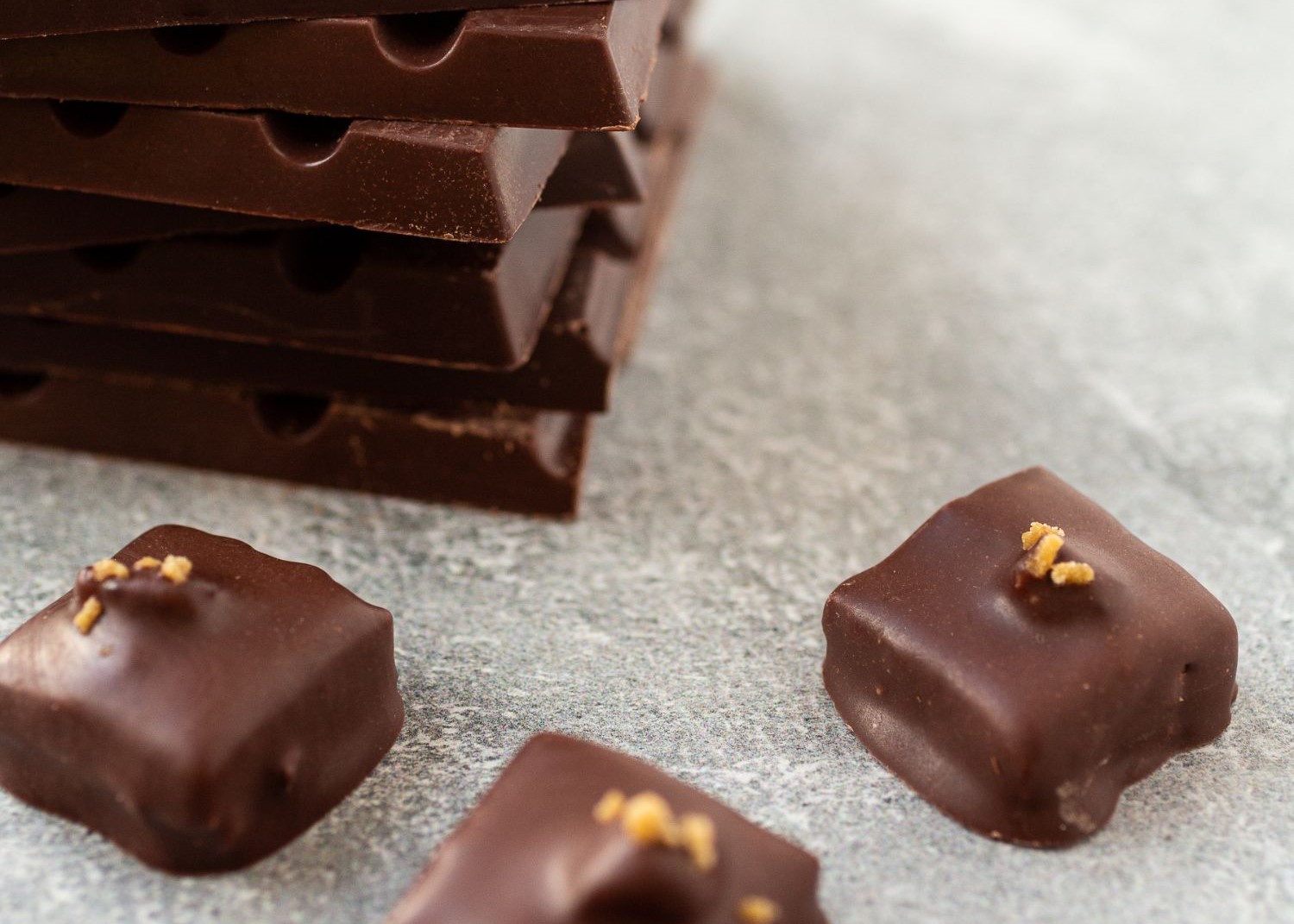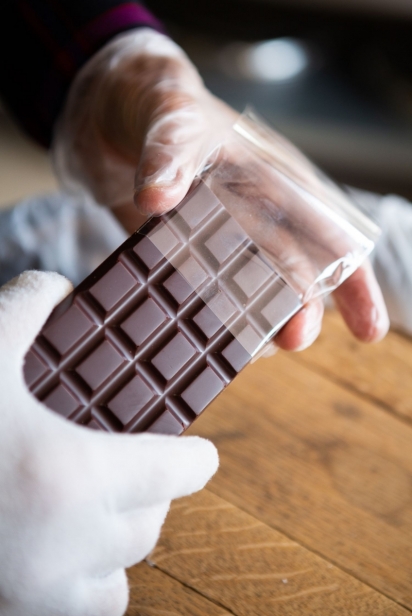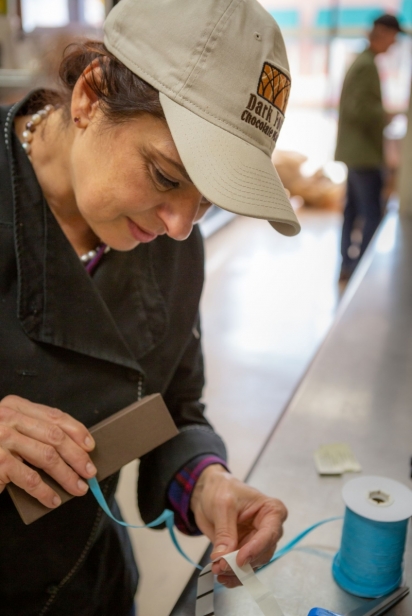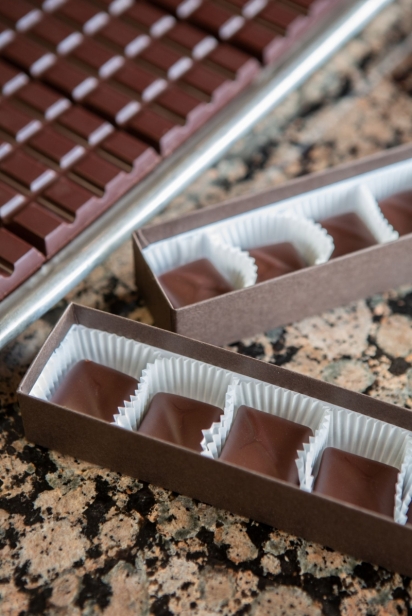Dark Forest Chocolate: From the Understory
A journey of just one step leads from Lancaster’s historic West Main Street to far-off tropical lands where cocoa grows on trees. Cross the threshold into the Dark Forest Chocolate Makers shop and your eyes and nose will confirm that you have arrived in someplace very different—and thoroughly delicious.
You’ll probably first be drawn to the line of windows along the room’s western wall, where most days co-owner Dan Sundell is making chocolate before your eyes. You might be captivated by the beautiful packaging and alluring flavors of their bars: Bourbon Cask-Aged Chocolate 70 percent, Dark Madagascar 65 percent, Goat Milk Chocolate 55 percent. You might notice the national and international awards they’ve garnered since they started in 2015, including a 2019 Good Food Award recognizing their Gimme Coffee Dark Chocolate bar. Or, you might marvel at a small bowl filled with cocoa beans—almond-sized, light brown and alien.
“A man wandered in yesterday asking about sponge candy,” Dan says. “And I had to explain, that’s not really what we do.”
Dark Forest is a bean-to-bar chocolate maker, a process spanning months and thousands of miles, ultimately leading to the chocolate bars on the shelf.
Bean-to-bar is still not exactly a household term—though it is gaining in popularity. Candymakers and chocolatiers like See’s nationally or Blue Table or Fowler’s locally are much more common, but differ greatly in process, sourcing blocks of chocolate from another company, which they then craft into their products. Dark Forest, on the other hand, starts with the cocoa bean.
Bean-to-bar chocolate making has been part of the artisan producer wave of the last decade or so, alongside coffee roasting and craft beermaking. However, while almost any medium-sized town in the U.S. now has a brewery—there are over 400 in New York State alone—making bean-to-bar chocolate remains comparatively rare, with only about 200 bean-to-bar operations in the entire country.
That’s because this is a process that is at once scientific, creative, laborious and challenging—in short, right up Dan Sundell’s alley. In 2013, looking for a change from his career as a landscape architect, he discovered bean-to-bar chocolate making. He started watching videos, investing in home equipment and scouting locally for inventive chocolate. “He’s like this with everything,” says Dark Forest co-owner JoAnne Sundell with a sidelong glance at her husband, recalling other hobbies like greenhouses and barefoot running. Luckily, making soy-free and nut-free bean-to-bar chocolate is a craft that demands dedication bordering on obsession.
It all begins with procuring high-quality cocoa beans. Dark Forest currently sources its beans from six origins—Tanzania, Ghana, Madagascar, Uganda, Costa Rica and Peru—going through Uncommon Cacao, a cocoa supplier committed to providing chocolate makers with transparently traded wholesale cocoa beans.
“When learning about chocolate, I quickly realized that you can’t avoid looking at fair trade and labor practices,” says Dan. Supporting fair labor practices is important to the Dark Forest Chocolate owners, and is the first cut in deciding where to source their beans.
According to the Food and Agriculture Organization of the United Nations, about 70 percent of the world’s cocoa comes from a handful of countries in West Africa, former European colonies where people have historically been exploited for labor. A 2019 report in the Washington Post indicates this exploitation in the form of child labor continues today, supported by big chocolate makers and their customers, who know little about the industry behind the often-inexpensive chocolate bar in their hands.
As a bean-to-bar chocolate maker, Dark Forest aims to close this gap, connecting their customers to the sense of place and pride that goes into chocolate production at every stage. The name Dark Forest itself alludes to the lovely and serene environment in which cocoa trees thrive: the understory of rainforests around the world.
Cocoa beans start off inside cocoa pods: colorful, football-sized fruits that weigh about four pounds apiece. They take six months to grow; after being harvested, the beans, along with the sticky white fruit inside the pods, are scooped out and fermented, a labor-intensive process that is integral to developing the flavor we associate with chocolate. Then the beans are dried, bagged up, sold and sent off.
Burlap sacks of cocoa beans arrive at Dark Forest, where they’re cleaned and then roasted. Like most small bean-to-bar producers, Dan has a hodgepodge of new and older, retrofitted equipment. Dark Forest’s roaster is a repurposed chicken rotisserie that’s been fitted with a drum. As with coffee roasting, this step is essential for bringing out the beans’ flavor. Like wine grapes, coffee and children, cocoa beans are a product of their environment; they are impacted by soil composition, weather, nearby crops, the microorganisms in the fermentation process and myriad other factors known as terroir.
Next is the winnower, a machine that breaks up the roasted bean and separates the thin outer husk from the pieces of bean inside, known as nibs. At this stage, the cocoa is bitter and acidic as well as crunchy and bold, reflective of its unique terroir, at turns evoking banana, peanuts, coffee and cherries.
Next, the nibs go into a melanger, where they are ground down. Like nuts, cocoa beans contain fat (around 50–55 percent), so this grinding brings out natural oils, transforming the nibs into a liquid—which looks deceptively like enticing chocolate but is not yet sweet. Dan then adds organic cane sugar and, if he’s making milk chocolate, milk powder. The ingredients mix with the lid open to tantalize lucky customers through the window, as well as to release the acidic flavor notes that remain from the fermentation process.
“I love the Excelsior 75 percent Dark,” says JoAnne, who also admits a weakness for their milk chocolate, which—at more than 50 percent cocoa content—is well over the average milk chocolate on the market, which often sits at just over 10 percent. “My favorite changes with each new batch,” says Dan.
Finally, Dan forms the chocolate into blocks, which he then ages for around three months to let the flavor develop. After that, he remelts it in a tempering machine that gradually cools the chocolate, setting its crystalline structure to ensure a pleasing texture and glossy exterior. The effect of chocolate becoming out-of-temper is “chocolate bloom”: the innocuous white film that appears on chocolate if it experiences a swift temperature change, or as it ages.
At last, the tempered chocolate goes into bar molds, briefly into a cooling cabinet, and finally the bars are wrapped, generally by the Sundells’ two teenaged sons. In 2019, the family sold 7,500 chocolate bars via three different sales streams: retail in their store, online orders and wholesale. Locally, their bars can be found at such places as the Lexington Co-op, Whole Foods, and Farmers & Artisans Market. They recently started selling their bars through FreshFix, a subscription box that delivers local produce as well a range of artisan products to customers’ doorsteps.
Needless to say, the coronavirus has changed things a bit: Customers can’t sample products in the shop; festivals and in-store demos are canceled; and any new ideas for tastings or events are on pause. However, they’ve found themselves busier and more grateful than ever. “Our customers are just so nice, and they support us every way they can,” Dan says.
Dan makes the chocolate and does the package design while JoAnne is in charge of the marketing, social media, sales and accounting. “We try to do whatever we can ourselves, big and small,” says Dan, who still consults as a landscape architect. JoAnne, who is also an adjunct history professor at Erie Community College, makes specialty offerings for the store, including chocolate-covered popcorn, marshmallows, barks, caramels and truffles, which change seasonally. The day of our interview, she’s excited to experiment with a truffle featuring New York State–produced port wine and fig jam.
They’re looking forward to continuing to be a part of Lancaster’s burgeoning. The West Main Street project, extending the street over to Aurora Street and ending with a new mini-roundabout, is set to be finished any day. New businesses are opening, including a Mexican restaurant and a wine bar, and Dan is also involved in the design of a new park being installed by the creek.
“When we moved into this space back in 2015, there was nothing here,” JoAnne recalls. “The roof leaked, and there were failed businesses across the street.” Dan and his brother, an architect, took months to renovate the spot to include retail, production and administrative space.
“Finally, one day, after months of pipes, painting and wires, I turned on our cocoa bean roaster—and it was this huge shift,” says Dan. The smell of chocolate flooded the air, at once calming and motivating, and he was overcome with emotion. “We’d been so busy that I’d forgotten all about the chocolate.”











